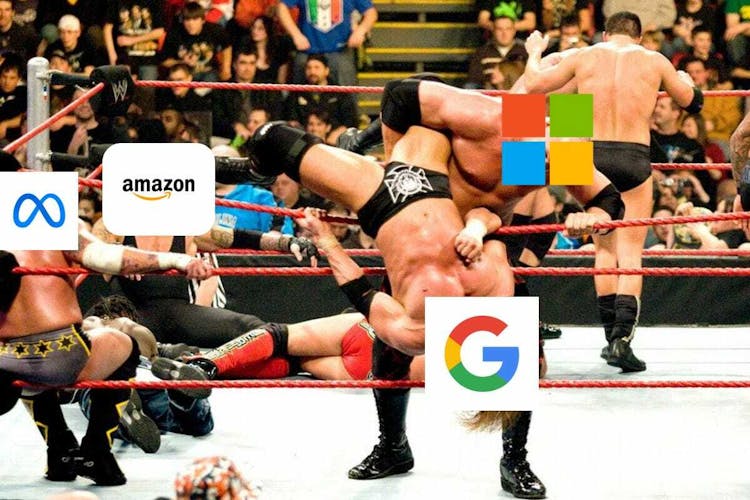Are we close to Singularity?
We discuss about JARVIS, AI Index Report and Singularity
Barun Pandey & Barun Sharma
April 07, 2023

GM! Welcome to The Status Code.
We're like culinary experts, preparing a delightful menu of AI advancements for you to taste.
Here’s what we have for today:
🌟Microsoft drops new framework
🔂AI Index Report 2023 Roundup
🤖Singularity: Embrace the Future?
(Estimated reading time: 3 minutes 45 seconds)
Not subscribed yet? Stay in the loop with AI weekly by reading the Status Code for five minutes.
Two Headlines
Two main stories of last week. If you have only ~2 minutes 15 seconds to spare
1/ 🌟Microsoft drops new framework

Microsoft keeps leveling up every week. This week, we have JARVIS and TaskMatrix.
1. JARVIS
When I first heard about JARVIS, I thought it was built by Andrej Karpathy (since his bio says he's building one).
But it turns out JARVIS is a different thing from Microsoft. It's an autonomous AI powered by HuggingFace and ChatGPT. According to Microsoft, JARVIS has four steps of processing:
Task Planning (find a hotel on April 20th)
Model Selection (choose hotelGPT)
Task Execution (search and tailor to user needs)
Response Generation (display hotel room #21 in Hotel X)
2. TaskMatrix
TaskMatrix is an AI ecosystem that connects foundation models with many task-completion APIs.
The goal of TaskMatrix is to build a tailored system for solving tasks. Before, you needed to input things into ChatGPT for it to answer.
With TaskMatrix, you can give one piece of data and ask it to do anything with it.
Then, all Microsoft needs is an integration tool like Zapier.
TaskMatrix has the potential to connect to millions of APIs, allowing for automation. This is even more powerful than the plugins released by OpenAI last week.
It means we'll have an interface to connect users with expert AI systems.
For example, You might ask ChatGPT or BARD about your shoulder pain. It could give you a list of good doctors and hospitals nearby.
But, with TaskMatrix, you might get a response like:
"Sounds like you have tendinitis in your shoulder; you may need surgery, which has been scheduled in 2 weeks at X hospital. Please confirm the details and bill in your email."
What do people think?
People are excited about the new models and ecosystem. Some believe that Microsoft is making use of OpenAI's efforts. Many appreciate the potential for automating workflows.

The model is so popular that it’s at trending #1 as of writing this article.
And some folks even want a Paul Bettany voice on these models just for fun!

2/ 🔂AI Index Report 2023 Roundup

The highly anticipated AI Index Report 2023 by Stanford was released this week. And it's 67% larger than the 2022 edition!
It offers some surprising insights you won't find in typical AI discussions on Twitter.
1. China excels in publishing and hardware
The Chinese Academy of Sciences is the top contributor to NLP, AI, and speech recognition research this year.
Interestingly, we haven't seen a groundbreaking AI tool from China yet. They announced Ernie, their version of ChatGPT.
But its release keeps getting delayed for improvements. China also had the most robots in 2021, followed by Japan and the USA. This shows their potential to dominate the AI market through hardware.
2. Better price-to-performance ratio for GPUs
GPU performance has improved by 1.4 times more than in 2021. This proves that Moore's law still applies to GPUs. The LLM models have also released their minified versions suitable to less-power machines.
3. Growing optimism about AI
This year, 39% of the world believes AI will primarily benefit society. And the male population loves AI more than the female ones.
4. Challenges in reasoning and planning
A new seven-assignment reasoning test was introduced this year. And AI models like GPT struggled with human-like reasoning and plan generation.
As for public opinion, it's a mixed bag. Some view the AI Index as merely a compilation of other researchers' work, while others criticize the outdated data(2021) in the first chapter.
Some even suspect ChatGPT wrote the whole thing!

One Trend
1 trend you can pounce on. Reading time: ~1 minute 30 seconds
🤖Singularity: Embrace the Future?

Singularity is an idea where technology grows out of control and becomes unstoppable.
It's like Skynet in the Terminator movie turning against humans.
Mathematician Jon Von Neuman first mentioned this concept in the 1950s. Later, sci-fi writer Vernor Vinge added more ideas.
Vinge even mentioned that there may never be a condition of singularity.
Today, we seem closer to singularity than ever, all thanks to industrial trends:

1. Personal Computers Era
This is the era of the OG’s, the millennials. This is also when I got my pilot’s license for Space Invaders.
In the 90s, people like my dad talked about how AI would affect jobs, but most didn't take it seriously. During this era, we saw the development of computers and graphical user interfaces.
2. Internet and Mobile Devices Era
Computers became smaller, and phones evolved. We went from button phones to high-end smartphones, leading to a massive increase in data and connectivity.
We also saw the rise of nanotechnology, including nanobots, nanosystems, and nanosensors. Self-assembling nanobots could be an exciting future development.
3. Advances in AI
All these technological changes led to AI advancements. Although AI was known in the 90s, it's only now that we're starting to use it widely.
Our progress in AI over the past four months is more than what we achieved in the last ten years. A report shows that almost half of AI experts believe we'll have autonomous AI by 2061.

So, AutoGPT could be our first step towards singularity. This model makes GPT-4 fully autonomous.
When asked to create an app, it scans the environment, downloads results, searches for solutions on Stackoverflow, and creates the best app.
People have used AutoGPT for design, coding, everyday tasks, and machinery. There are two main ways how this could work:
Positive goals
Business goals
Positive goals involve building a future where humans and machines coexist and optimize resources.
Personal business goals include creating viruses or making future predictions based on businesses. While it might benefit large companies in the short term, it could backfire in the long term.
Currently, it seems we're choosing the second path, which could be a big mistake in the name of the automation.
Do we need singularity soon, or should we wait until we have more stable systems?

🦾What happened this week
Cyborg Content released their AI blog post writer
Luma AI released their new Unreal Engine alpha
Have a look at this chart which shows the valuations of Generative AI
Vicuna, a Chatbot based on LLaMA-13B, was released
Read this analysis of 112 AI startups from the latest YC batch
AWS launched a global GenAI-startup accelerator program
Microsoft launched JARVIS, an autonomous AI
AI-powered chatbot for developers Rix was released
A valuation chart for Generative AI startups was released
AI design tool Spline AI was released
Meta released a state-of-the-art computer vision tool
💰Funding Roundup
Danish health tech startup Teton.ai collected €4.8 million in funding
Sales outreach company Customer.ai raised $4.99M in Series A funding
Covariant, an AI robotics company, raised $75M in Series C funding
Ossus-Biorenewables raised $2.4M to accelerate AI-powered production
Agtech AI startup Agrinorm raised a seven-digit round of financing
Lightmetrics, a video platform, raised $8.5M in Series A funding
AI-research platform Portrait Analytics raised $3M in pre-seed funding
Native AI, a market intelligence platform, closes $3.5M in seed funding
Field Materials, a procurement AI company, raised $4.6M in seed funding

🐤Tweet of the week
There are lots of AI tools out there, but there are really only 6 major general-purpose AI Large Language Models. Most are free.
A lot of confusion online comes from not knowing the pluses & minuses of the model you are using. Here’s a guide & chart. https://oneusefulthing.substack.com/p/how-to-use-a…/
— Ethan Mollick (@emollick)
10:26 PM • Apr 5, 2023
😂 Meme of the week


That’s it for this week, folks! If you want more, be sure to follow our Twitter (@CallMeAIGuy)
🤝 Share The Status Code with your friends!
Did you like today's issue? |


